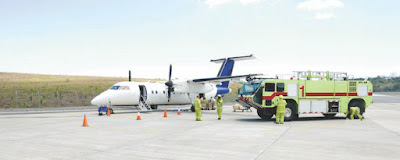How much fire extinguishing agent should an ARFF department have available? Is there a set amount of agent that is needed? What are some guidelines for determining agent quantity?
NFPA 402, Guide for Aircraft Rescue and Firefighting Operations, acknowledges that it would be impractical to keep a stock of extinguishing agent on hand for the worst case scenario. To mitigate any issue of an extinguishing agent shortage, pre-arrangements should be made. Pre-fire plans and mutual aid agreements should detail the expectations for additional agencies to provide aid in the form of bringing additional agent to the scene. Support should be requested early in an incident.
The initial water supply on a piece of apparatus should be assumed to be used up within 5 minutes of the incident. Based on the fact that ARFF apparatus carry enough agent (foam) for at least 1 water refill, NFPA 403, Standard for Aircraft Rescue and Firefighting at Airports requires 100% refill capability within the critical rescue and firefighting access area.
The critical rescue and firefighting access area is a rectangular area extending 500 feet out from the centerline of the runway, and 3,300 feet beyond each end of the runway. It is within this space that most aircraft accidents are expected to occur.
To determine the 100% capability a needs analysis must be conducted. All water sources and refill capabilities should be assessed. Recommendations for meeting the 100% refill requirements should be made. These recommendations may include water sources from:
- Tankers or structural equipment
- Hydrants
- Mutual aid agreements
The critical concern is that water is available to provide continuous attack to the fire until extinguished.
Related Posts
- The Art of ARFF (series)
- ARFF for Structural Departments
- Dubai International ARFF Incident
- Rapid Refueling and NFPA 407


